



An NHS on breaking point is urging Brits to use an online service to reduce swelling demand this winter.
NHS England launched its annual NHS 111 Online campaign today that directs people in need of urgent healthcare to local treatments.
As the NHS faces a daunting patient backlog, health officials estimate that two-fifths of A&E attendances are avoidable or could be better treated elsewhere.
People are asked to go to 111.nhs.uk and log in their postcode, age, sex and main symptom before asking a few questions about their health concerns.
Emergency wards up and down the UK were filled with more than 2.17 million patients last month in what the NHS said was the ‘busiest ever October’.
Ambulance services responded to 83,986 calls over that period.
Professor Sir Stephen Powis, NHS national medical director, said the campaign comes amid growing fears of a ‘twindemic’ of flu and Covid-19 choking the NHS.
When to call NHS 111
People are advised to call the non-emergency medical helpline if they need to:
- discuss complex medical problems
- discuss worries about a long-term condition
- for end-of-life care or to report a death
- report child protection or vulnerable adult concerns


‘Last month our hard-working staff contended with another record month of A&E attendances and the most serious ambulance call-outs, which is only the tip of the iceberg of the growing pressures that the NHS is facing this winter, including the threat of a “twindemic” of covid and flu, and reduced hospital capacity caused by issues discharging patients into social care,’ he said.
‘This new campaign will remind the public that NHS 111 online is available to signpost people to the best option for their care needs ahead of winter – it can provide the most appropriate local treatment option for medical issues quickly without needing to leave your home and saving you an unnecessary trip to A&E.’
‘It is vital that people continue to use A&E and call 999 in an emergency so as ever, please do come forward for the care you may need.’
There are many reasons why more people are turning to emergency departments, according to a report by the British Red Cross.
Around 1% of the British population attend A&E ‘frequently’, such as going five times per year, but they amount to 16% of A&E attendances.
Two of the biggest reasons for this are ‘deprivation and inequalities’, the charity said.
‘Housing insecurity, homelessness, loneliness, and mental health issues are other common factors,’ the report added.
Get in touch with our news team by emailing us at webnews@metro.co.uk.
For more stories like this, check our news page.
